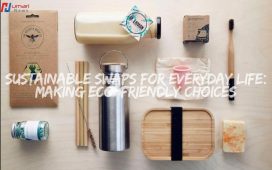The Earth is facing unprecedented challenges, and many of us are looking for ways to reduce our environmental impact. Fortunately, there are many small changes we can make in our daily lives that can collectively create a significant positive difference. This doesn’t require a complete lifestyle overhaul – even a few simple swaps can put you on the path to a more sustainable future.
Embrace Reusables
Our dependence on single-use plastics is a major contributor to environmental pollution. Thankfully, there are easy swaps you can make to ditch disposables and embrace reusables.
- Ditch the plastic bags: Invest in a set of reusable shopping bags made from sturdy canvas or recycled materials. Keep them handy in your car or bag so you’re never caught needing a plastic option.
- Water on the go: Instead of buying bottled water, carry a reusable water bottle. Opt for a stainless steel or glass bottle to keep your beverage cold and avoid harmful chemicals that can leach from plastic.
- Coffee fix with less waste: Many coffee shops offer discounts for bringing your own travel mug. This small swap can save you money and significantly reduce waste.
- Food storage solutions: Ditch plastic wrap and aluminum foil. Glass containers are a great option for storing leftovers and lunches. For short-term covering, consider reusable beeswax wraps, which are both eco-friendly and effective.
Reduce, Reuse, and Replenish in the Kitchen
The kitchen is a prime spot to implement sustainable practices. Here are some tips:
- Plan your meals: This helps reduce food waste, which is a major environmental issue. Plan meals for the week, create a shopping list, and stick to it to avoid impulse purchases that may spoil.
- Shop smart: Buy local and seasonal produce whenever possible. This reduces transportation emissions and supports local farmers.
- Embrace the power of leftovers: Plan meals that can be easily repurposed into lunches or transformed into new dishes.
- Compost food scraps: Food scraps that can’t be eaten can be composted. Compost is a nutrient-rich soil amendment that can be used to fertilize your garden, reducing your reliance on chemical fertilizers.
Power Down and Conserve
Our energy consumption has a significant impact on the environment. Here’s how to be more mindful:
- Unplug unused electronics: Even electronics in standby mode use energy. Get in the habit of unplugging chargers, computers, and other devices when not in use.
- Embrace LED lighting: LED bulbs are much more energy-efficient than traditional incandescent bulbs. They last longer and emit less heat, reducing your overall cooling needs.
- Wash clothes with cold water: Most laundry detergents are effective in cold water, so opt for the cooler setting to save energy.
- Air dry clothes whenever possible: Skip the dryer and hang your clothes to dry naturally. This is not only good for the environment but can also extend the life of your clothes.
Get Moving Sustainably
Transportation is a major contributor to greenhouse gas emissions. Here are some ways to get around with a lighter footprint:
- Walk or bike: For short trips, consider walking or cycling. This is not only good for the environment but also a great way to get some exercise.
- Embrace public transportation: If walking or cycling isn’t an option, utilize public transportation whenever possible. This reduces your reliance on a car and its associated emissions.
- Carpool or rideshare: When you do need to drive, consider carpooling with colleagues or using a rideshare service. This reduces the number of cars on the road, which can help to improve air quality.
Beyond the Basics
While the swaps mentioned above are a great starting point, there are many other ways to live more sustainably:
- Support sustainable businesses: Do your research and choose to support companies that prioritize environmental responsibility.
- Embrace secondhand: Before buying new, consider buying items secondhand. This reduces demand for new products and gives pre-loved items a new life.
- Get crafty: Learn to repair clothes, mend broken items, and upcycle unwanted materials. This reduces waste and saves you money.
Remember, sustainability is a journey, not a destination. Start with a few swaps that fit easily into your lifestyle and gradually incorporate more as you become comfortable. Every little bit counts, and by working together, we can create a greener future for ourselves and generations to come.







